|
Topics to be learn :
- Benefits of animal classification
- Non Chorodates and Chorodate
- New system of animal classification
- Kingdom Anamalia
- Vertebrata
|
Criteria for classification of organisms: The living organisms are classified according to their basic characteristics, such as presence or absence of nucleus, unicellular body or multicellular body, presence or absence of cell wall and the mode of nutrition in them.
Plants classification : The plants are classified according to the following basis :
- Presence or absence of the organs.
- Presence or absence of separate conducting tissues for the conduction of food and water.
- Presence or absence of seeds in plants.
- Whether seeds are enclosed in fruits or not.
- Number of cotyledons in seeds: one or two.
Animal Classification :
- There is great diversity among the animals on the earth. There are about 7 million species of different animals.
- Depending upon the similarities & differences among these animals, they have been classified.
- Such systematic classification makes it easy to study the great diverse animal forms.
History of Classification :
History of Classification :
1) Scientists : Greek philosopher Aristotle Theophrastus, Pliny, John Ray, Linnaeus.
- Basis for classification : Body size, habits and habitats
- Method : Artificial method
2) Scientists : Dobzhansky and Mayor
- Basis for classification : Body organization, types of cells, chromosomes, bio-chemical properties
- Method : Natural system of classification
3) Scientists : Carl Woese
- Basis for classification : Presence or absence of notochord.
- Method : Method based on evolution Traditional method.
[collapse]
Benefits of animal classification :
(1) By placing the animals in proper classified groups, their study becomes convenient.
(2) By studying few animals from each group understanding the entire group becomes easy.
(3) Animal classification leads to better understanding of animal evolution.
(4) Identification of animals can be done with great accuracy.
(5) The relationship of animals with other living organisms is better understood.
(6) The habitat of each animal and it’s exact role in the nature can be understood by learning animal classification.
(7) Various adaptations of animals can be studied.
Traditional method of animal Classification :
Traditional method of animal Classification :
Animal classification : Formation of groups and sub-groups of animals by taking into account their similarities and differences is called animal classification.
Non Chorodates :
- Notochord: Absent
- Pharyngeal Gill slits: Absent
- Nerve cord: Ventral, solid and paired
- Heart: Dorsally locate
Chorodates :
- Notochord: Present
- Pharyngeal Gill slits: Present
- Nerve cord: Dorsal, hollow and single
- Heart: Ventrally located
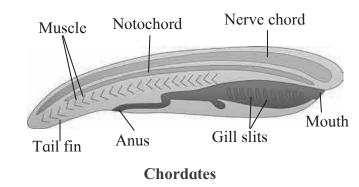
Chordates : All chordate animals are belong to the single group which is called Chordata,
Chordata has three subphyla, viz.
- Urochordata
- Cephalochordata
- Vertebrata
Sub-phylum Vertebrata is further divided into following six Classes as :
- Cyclostomata
- Pisces
- Amphibia
- Reptilia
- Aves
- Mammalia
[collapse]
Robert Whittaker has given five kingdom classification system. All the multicellular, heterotrophic organisms are included under kingdom Animalia or Animal kingdom.
According to this system the criteria for classification are as follows :
(1) Body organization (2) Body symmetry (3) Body cavity (4) Germinal layers (5) Segmentation.
New system of animal classification :
Criteria for new system of classification :
(1) Grades of organization :
(1) Grades of organization : Unicellular organisms have a single cell. But in multicellular animals there are many cells.
| Grades of Organization |
|
| Protoplasmic grade |
Body made up of only protoplasm. E.g. Unicellular animals. |
| Cellular grade |
Many cells are present. But tissues are not formed. E.g. Porifera |
| Cell-tissue grade |
Cells performing similar function form the tissues. Tissues perform all body functions. E.g. Cnidaria |
| Tissue Organ grade |
Tissues are organized to form some organs. But complete organ systems are not formed. E.g. Flat worms |
| Organ-system grade |
Different organs form organ system to perform specific functions in the body. E.g. Human beings and other higher animals |
[collapse]
(2)Body Symmetry :
(2)Body Symmetry :
if body of any animal is cut through imaginary axis of body, it may or may not produce two equal halves. Depending upon this property, there are different types of animal bodies.
- Asymmetrical Body : In case of such body, there is no any such imaginary axis of the body through which we can get two equal halves. Ex. Amoeba, Paramoecium, some sponges.

- Radial symmetry : In this type of body, if imaginary cut passes through central axis but any plane of body, it gives two equal halves. Ex. Star fish. In case of this animal, there are five different planes passing through central axis of body through which we can get two equal halves.
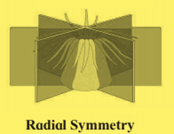
- Bilateral symmetry: In this type of body, there is only one such imaginary axis of body through which we can get two equal halves. Ex. Insects, fishes, frog, birds, human, etc.
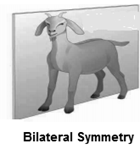
[collapse]
(3) Germ Layers:
(3) Germ Layers:
- During the initial embryonic period of any multicellular animal there is formation of germinal layers or germ layer.
- These germ layers give rise to new tissues in the developing animal.
- The primitive animals have only two germ layers called ectoderm and endoderm. This condition is called diploblastic.
- The higher animals have three germ layers: ectoderm, mesoderm and endoderm. This is called triploblastic nature.
- Cnidarians are diploblastic while all other animals are triploblastic.
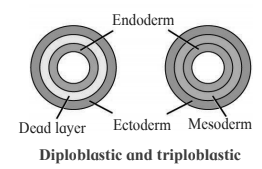
[collapse]
(4) Body cavity (Coelom) :
(4) Body cavity (Coelom) :
Cavity between the body and internal organs is called as body cavity/coelom.
Eucoelomate : Body cavity present. During initial embryonic development period body cavity is formed from either mesoderm or gut. Example- All animal phyla from Annelida to higher phyla.
Acoelomate : Absence of coelom. Example- Porifera, Cnidaria and Platyhelminthes.
Pseudocoelomate : Body cavity is present but it is not formed by the mesoderm or gut. Hence it is not true coelom. Example-Aschelminthes.
[collapse]
(5) Segmentation :
(5) Segmentation : Segmentation is the phenomenon in which the body of animals is divided into segments which are small, similar units. Body with segments is segmented body. E.g. Phylum Annelida shows segmented bodied animals.
[collapse]
Kingdom Animalia-
Classification of Non-chordates into ten phyla :
(1) Protozoa (2) Porifera (3) Coelentarata/Cnidaria (4) Platyhelminthes (5) Aschelminthes (6) Annelida (7) Arthropoda (8) Mollusca (9) Echinodermata (10) Hemichordata
1) Protozoa :
1) Protozoa : (reference class 8 Science Chapter1)
- Habitat : Protozoans are found in soil, fresh water and sea water. Some are found in the body of other organisms and are pathogenic.
- Characteristics : These are unicellular organisms with eukaryotic cell.
- Locomotion:There is great variation in cell structure, organs of locomotion and modes of nutrition among protozoans.
- Reproduction :These organisms reproduce by simple cell division.
- - Amoeba, Paramoecium - Free living in dirty water. Entamoeba histolytica - causes amoebiasis. Plasmodium vivax- causes malaria, Euglena - autotrophic
[collapse]
2) Phylum- Porifera
2) Phylum- Porifera
- Body Structure: These animals are with simplest body plan and are called as ‘Sponges’. They bear numerous pores on their body. Those pores are called as ‘Ostia’ and ‘Oscula’.
- Habitat : These are aquatic animals. Most of them are marine and few are fresh water dwellers.
- Body Symmetry :Most of the animals have asymmetrical body.
- Characteristics :These animals have special types of cells- collar cells.
- Their spongy body is supported by spicules or sponging fibres. Spicules are made up of calcium carbonate or silica.
- These animals feed upon small organisms taken in their body along with water. Water is taken in through ostia and given out through oscula.
- Germinal Layers coelom : Acoelomate, cellular grade
- Locomotion: These animals are always attached to substratum, hence do not show locomotion. Hence, they are referred as sedentary animals.
- Reproduction :These animals reproduce by budding, an asexual method and / or by sexual method. Besides, they have good ability of regeneration.
- Examples: Sycon, Euspongia (Bath sponge), Hyalonema, Euplectella, etc.
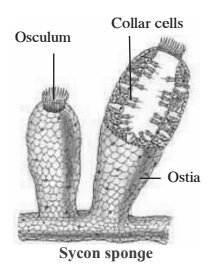
[collapse]
3) Phylum - Coelenterata/Cnidaria
3) Phylum - Coelenterata/Cnidaria
- Body Structure: Body of these animals is cylindrical or umbrella-like. If it is cylindrical, it is called as ‘Polyp’ and if it is umbrella like called as ‘Medusa’.
- Habitat : Most of these animals are marine. Only few are fresh-water dwellers.
- Body Symmetry : Body of these animals is radially symmetrical & diploblastic.
- Characteristics :Cnidoblast bearing tentacles are present around the mouth. Tentacles are useful for capturing the prey whereas cnidoblasts inject the toxin in the body of prey. Those are useful for protection too.
- Locomotion: sedentary or free swimming
- Germinal Layers coelom : Acoelomate, Diploblastic.
- Reproduction : Asexual, Sexual
- Examples: Hydra, Adamsia (Sea anemone), Physalia (Portuguese- man-of war), Aurelia (Jelly fish), Corals, etc.
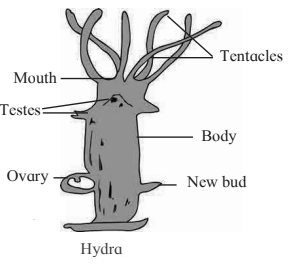
[collapse]
4) Phylum - Platyhelminthes
4) Phylum - Platyhelminthes
- Body Structure: Body of these animals is slender & flat like a leaf or strip. Hence, they are called as ‘flatworms’.
- Habitat : Most of these animals are endoparasites, Few are free-living & aquatic.
- Body Symmetry : Bilaterally symmetrical.
- Characteristics : Flat body is a typical character.
- Locomotion: Swimming
- Germinal Layers coelom : Body is Acoelomate and triploblastic i.e. their body is made up of three germ layers- endoderm, ectoderm & mesoderm.
- Reproduction : Bisexual, Sexual. These animals are hermaphrodite i.e. male and female reproductive systems are present in the same animal body.
- Examples: Planaria, Liverfluke, Tapeworm, etc.

[collapse]
5) Phylum- Aschelminthes
5) Phylum- Aschelminthes
- Body Structure: Body of these animals is long thread-like or cylindrical. Hence, they are called as round worms.
- Habitat :These animals are either free living or endoparasites. Free living animals are either aquatic or terrestrial.
- Body Symmetry : Bilaterally symmetrical.
- Germinal Layers coelom : Body of these animals is triploblastic and pseudocoelomate.
- Characteristics : Body of these animals is non-segmented and covered with tough cuticle.
- Locomotion: Swimming
- Reproduction :These animals are unisexual.
- Examples: Ascaris (Intestinal worm), Filarial worm, Loa loa (Eye worm), etc.
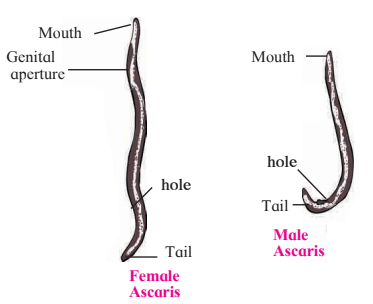
[collapse]
6) Phylum - Annelida
6) Phylum - Annelida
- Body Structure: Body of these animals is long, cylindrical & metamerically segmented.
- Habitat :Most of the animals are free-living, but few are ectoparasites. Free-living animals may be marine or fresh water dwellers or terrestrial.
- Body Symmetry : Bilaterally symmetrical
- Germinal Layers coelom : These animals are triploblastic, and eucoelomate.
- Locomotion: They have setae or parapodia or suckers for locomotion.
- Characteristics :Their body is covered with special cuticle.
- Reproduction : These animals are either hermaphrodite or unisexual.
- Examples: Earthworm, Leech, Nereis, etc.
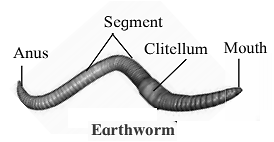
[collapse]
7) Phylum- Arthropoda
7) Phylum- Arthropoda
- Body Structure: These animals have jointed appendages. Hence they are called as arthropods.
- Planet Earth has highest number of animals from this phylum. Hence, this is largest phylum with highly successful animals in animal kingdom.
- Habitat :These animals are found in all types of habitats ranging from deepest oceans to highest mountains.
- Germinal Layers coelom : Body of these animals is triploblastic, eucoelomate,
- Body Symmetry : Bilaterally symmetrical and segmented.
- Locomotion: Swimming, creeping
- Characteristics : Chitinous exoskeleton is present around their body.
- Reproduction : These animals are unisexual.
- Examples: Crab, spider, scorpion, millipede, centipede, cockroach, butterfly, honey bee, etc.
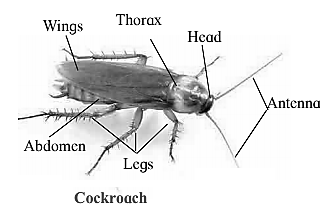
[collapse]
8) Phylum- Mollusca
8) Phylum- Mollusca
- Body Structure: Body of these animals is soft and slimy. Hence they are referred as mollusc.
- This is second largest phylum in animal kingdom.
- Habitat : These animals are aquatic or terrestrial. Most of the aquatic molluscs are marine, but few are fresh water dwellers too.
- Germinal Layers coelom : Body of these animals is triploblastic, eucoelomate, non-segmented and soft.
- Body Symmetry : Except animals like snail, their body shows bilateral symmetry. Their body is divided into three divisions like head, foot and visceral mass.
- Locomotion: Swimming, creeping by floor
- Characteristics : Visceral mass is covered with mantle. This mantle secretes a hard, calcareous shell. This shell may be external or internal or even absent in some cases.
- Reproduction : These animals are unisexual.
- Examples: Bivalve, Snail, Octopus, etc.
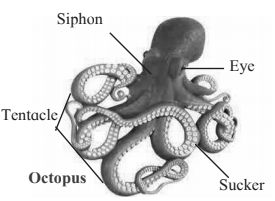
[collapse]
9) Phylum- Echinodermata
9) Phylum- Echinodermata
- Body Structure: Calcareous spines are present on the body of these animals; hence they are called as echinoderms.
- Habitat : These animals are found only in ocean.
- Germinal Layers coelom : Their body is triploblastic, eucoelomate.
- Body Symmetry : It is radially symmetrical in adult stage. However, they show bilateral symmetry in larval stage.
- Locomotion: They perform locomotion with the help of tube-feet. Tube feet are also useful for capturing the prey. Some animals are sedentary.
- Characteristics : They have skeleton made up of calcareous spines and / or ossicles (plates).
- Reproduction : These animals have good ability of regeneration. These animals are mostly unisexual.
- Examples: Star fish, sea-urchin, brittle star, sea-cucumber, etc.

[collapse]
10) Phylum- Hemichordata
10) Phylum- Hemichordata
- Body Structure: Body of these animals is divided into three parts as proboscis, collar & trunk.
- Notochord is present in proboscis region only. Hence, they are called as hemichordates.
- These animals are also called as ‘acorn worms’.
- Habitat : These are marine animals, live in burrows in sand.
- Characteristics : They have one to many pharyngeal gill slits.
- Reproduction : They are unisexual or some may be hermaphrodite.
- Example : Balanoglossus, Saccoglossus.
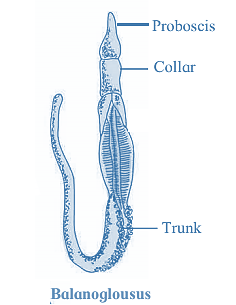
[collapse]
Chordates :
Phylum-Chordata
Animals having a supporting notochord in their body are called Chordates.
Characters of phylum Chordata:
(1) Presence of notochord in the body either throughout the life or at least in the developmental stage.
(2) Presence of pharyngeal gill slits. (at least during developmental stage).
(3) Presence of single, tubular and dorsal spinal cord.
(4) Presence of ventrally situated heart.
Depending on the notochord, the Phylum chordata is classified into three subphyla.
Urochordata, Cephalochordata and Vertebrata/Craniata
A. Subphylum - Urochordata
A. Subphylum - Urochordata
- Urochordates are animals having notochord only in tail region of larvae.
- Marine, sedentary adults.
- Larvae are free swimming, they metamorphose into sedentary adults.
- Body is covered by test or tunic. This is a covering like a skin.
- Hermaphrodite animals.
- Examples : Herdmania, Doliolum, Oikopleura, etc.

[collapse]
B. Subphylum - Cephalochordata
B. Subphylum - Cephalochordata
- Notochord is present in entire body length.
- Small, fish-like, marine animals.
- Large pharynx having gill-slits.
- Unisexual animals.
- Example : Amphioxus.

[collapse]
C. Subphylum - Vertebrata/Craniata
Vertebrata has been divided into six classes.
1.Class- Cyclostomata :
1.Class- Cyclostomata :
- Body Structure: These animals have jaw-less mouth provided with sucker.
- Their skin is soft and without any scale.
- Thermoregulation : Cold blooded animals
- Appendages : Paired appendages are absent.
- Exoskeleton : Soft skin without any scales. Endoskeleton is cartilaginous.
- Habitat : Most of the animals are ectoparasites. Marine,aquatic
- Respiration: Respiration occurs with gills.
- Reproduction :Oviparous-Eggs
- Examples: Petromyzon, Myxine, etc.

[collapse]
2. Class- Pisces
2. Class- Pisces
- Habitat : These are cold blooded (Poikilotherms) aquatic animals living in marine and fresh waters.
- Body Structure: Body is spindle shaped to minimizewater-resistance.
- Thermoregulation : Cold blooded animals
- Appendages : They have paired & un-paired fins for swimming. Tail fin is useful as a steering organ during swimming.
- Exoskeleton : Exoskeleton is in the form of scales & endoskeleton is either cartilaginous or bony.
- Respiration: Respiration occurs with gills.
- Reproduction :Oviparous-lay Eggs
- Example : Rohu, Pomfret, Sea horse, Shark, Electric ray, Sting ray, etc.
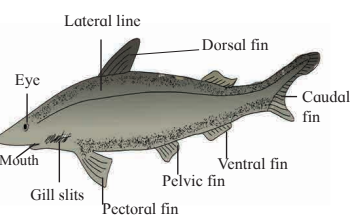
[collapse]
3. Class- Amphibia
3. Class- Amphibia
- Habitat : These animals are strictly aquatic during larval life and perform only aquatic respiration whereas they can live in water as well as on land during adult life and can perform aquatic as well as aerial respiration.
- Appendages :They have two pairs of appendages. Digits are without claws.
- Exoskeleton : Exoskeleton is absent. Skin is without any derivative and usually kept moist for respiration.
- Body Structure: Neck is absent. Eyes are prominent with eye lids. External ear is absent but tympanum is present.
- Thermoregulation : Cold blooded animals
- Respiration: During tadpole/larval stage by gills, In adulthood by skin in water and by lungs when on land
- Reproduction : Eggs, larva, adult metaphorphosis.
- Example : Frog, Toad, Salamander, etc.
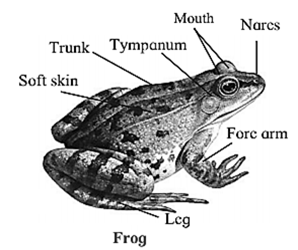
[collapse]
4. Class- Reptilia
4. Class- Reptilia
- Habitat : According to the course of animal evolution, these are first true terrestrial animals with creeping movement. Few are aquatic
- Thermoregulation : These are cold blooded (poikilotherms) animals.
- Appendages : Two weak pairs of limbs. Digits are provided with claws.
- They creep on the land as their body cannot be lifted up.
- Exoskeleton : Their skin is dry and scaly.
- Body Structure: Neck is present between head & trunk. External ear is absent.
- Respiration: By lungs.
- Reproduction : Eggs, young one, adults.
- Examples: Tortoise, Lizard, Snake, etc.
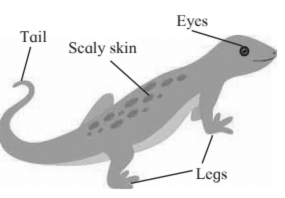
[collapse]
5. Class- Aves
5. Class- Aves
- Habitat : These vertebrates are completely adapted for aerial life.
- These are warm blooded (Homeotherms) i.e. they can maintain their body temperature constant.
- Body Structure: Their body is spindle-shaped to minimize air resistance during flight. Neck is present between head and trunk. Jaws are modified into beak.
- Thermoregulation : Warm blooded animals
- Appendages : Forelimbs are modified into wings. Digits are covered with scales and bear claws.
- Exoskeleton : Exoskeleton is present in the form of feathers.
- Respiration: By lungs aided by air sacks.
- Reproduction : Oviparous, parental care.
- Examples: Peacock, Parrot, Pigeon, Duck, Penguin, etc
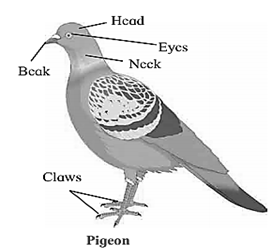
[collapse]
6. Class- Mammalia
6. Class- Mammalia
- Habitat : Mainly terrestrial, few aquatic, few aerial.
- Presence of mammary glands is typical character of mammalia.
- Thermoregulation : These animals are warm blooded.
- Body Structure: Body is divided into head, neck, trunk and tail.
- Appendages : Digits are provided with nails, claws, or hooves.
- Exoskeleton : Exoskeleton is in the form of hairs or fur.
- Respiration: By lungs aided with diaphragm.
- Reproduction : Few Oviparous, majority viviparous. Birth to live young, mammary glands secreting milk.
- Examples: Elephant, Human, Kangaroo, Dolphin, Bat, etc.

[collapse]
Q. Complete the Chart by taking into consideration the criteria for classification :
Q. Animals like ghariyal and crocodile live in water as well as on land. Are they amphibians or reptiles?
Answer
Ghariyal and crocodile are reptiles. They can swim in water and crawl on land. But they can respire only with the help of lungs. Their breathing is through nostrils. Even when in water, they have to inhale and exhale by coming up to the surface of water for air. Amphibians can breathe through the skin when in water and by lungs when on land. They also have hard exoskeleton which amphibians do not have. Ghariyal and crocodile cannot do so, hence they are not amphibians, but they are reptiles.
Q. Animals like whale, walrus live in water (ocean). Whether they are included in Pisces or Mammalia?
Answer
Whale and walrus are aquatic and marine mammals. They do not belong to class Pisces. They do not have gills to breathe in dissolved oxygen in water. Neither they have scales on the body nor can they lay eggs. Whales and walrus have mammary glands like all other mammals. They give birth to live young one. They breathe only with the help of lungs by putting their nostrils out of the water at surface. Hence they are included in Mammalia.
Q. Why is earthworm called as friend of farmers?
Answer
- Earthworms move through the soil in thefarms and fields. They feed on the detritus in the soil
- They also help in decomposition of the organic matter.
- When the soil is loosened due to their activities, the roots of the crops grow well.
- They enrich the soil by their excreta which act as fertilizers.
- All these facts make earthworm a farmer’s friend.
Q. In what way the leech is used in ayurvedic system of treatment?
Answer
Leeches are blood sucking ectoparasite. In ayurveda leech is used to remove impure blood and blood clots. Such blood is sucked up by leeches and then the patient gets some relief. In the leech body there is a substance called hirudine which prevent plood clotting as it sucks up the blood. This hirudine is also used for medicinal purpose.
Q. What is chitin?
Answer
Chitin is a type of polysaccharide. Its chemical formula is (C8H13O5N)n. It is a long-chain polymer of N-acetylglucosamine, which is actually a derivative of glucose. It is a primary component of cell walls in fungi, the exoskeletons of arthropods, such as crustaceans and insects. In many medicines chitin is used. The industrial processes and the biotechnological experiments also use chitin.





















Main imp points are needfull
We require this please for as
Noted, Thanks for valuable suggestion
Very useful for self study, thanks